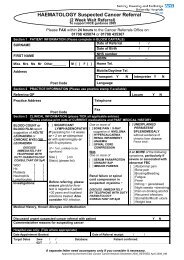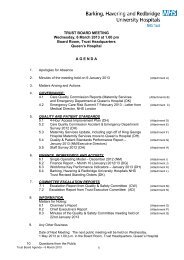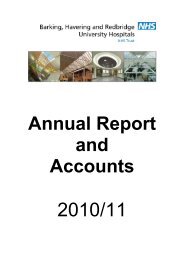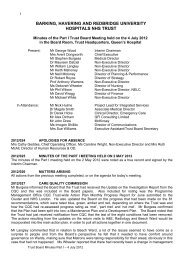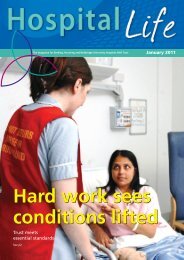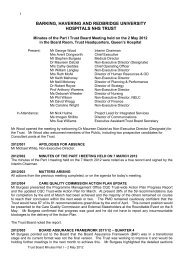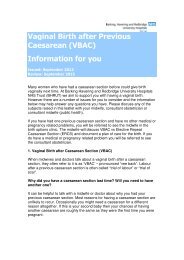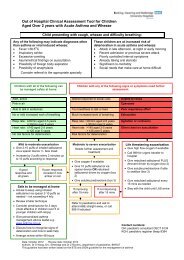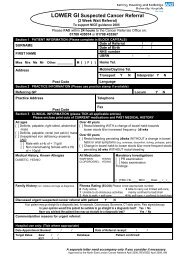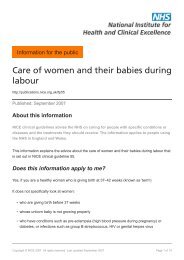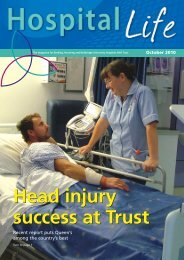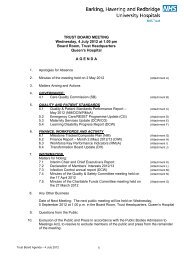Trust Board papers November 2012 - Barking Havering and ...
Trust Board papers November 2012 - Barking Havering and ...
Trust Board papers November 2012 - Barking Havering and ...
Create successful ePaper yourself
Turn your PDF publications into a flip-book with our unique Google optimized e-Paper software.
<strong>Trust</strong>’s risk matrix <strong>and</strong> will populate the <strong>Trust</strong>’s Risk Register <strong>and</strong> be escalated in line with<br />
the <strong>Trust</strong>’s escalation process.<br />
4.6 RISK GRADING AND ACCEPTABLE / UNACCEPTABLE RISK<br />
4.6.1 Grading<br />
Once risks are identified, it is the policy of the <strong>Trust</strong> that they must be prioritised for full<br />
assessment <strong>and</strong> management by initially grading them, according to their impact <strong>and</strong> the<br />
likelihood that they will occur again in the future.<br />
The <strong>Trust</strong> has adopted a risk assessment matrix for grading all non-financial risks whether<br />
clinical, non-clinical or organisational. The matrix is set out in the <strong>Trust</strong>’s Risk Assessment Tool<br />
Kit, which can be found on the <strong>Trust</strong>’s Intranet. The grading matrix is attached in Appendix 1. It<br />
has four grades of risk - low, moderate, high <strong>and</strong> extreme, which are identified respectively by the<br />
four colours: green, yellow, orange <strong>and</strong> red.<br />
Incidents are also graded using the same matrix in accordance with the <strong>Trust</strong>’s Incident Reporting<br />
& SI Policy which can be accessed on the <strong>Trust</strong>’s intranet.<br />
4.6.2 Acceptable / Unacceptable Risk<br />
It is the policy of the <strong>Trust</strong> that control action is:<br />
• considered for all risks where the initial grading is more than green / low<br />
• implemented to reduce the residual risk after the action to green / low, unless the impact<br />
<strong>and</strong> likelihood of the risk is such that the burden of the available action is disproportionate<br />
to the reduction of risk to be achieved.<br />
Thus, risks graded low / green need to be revisited annually unless further concerns arise.<br />
Yellow <strong>and</strong> low orange (under a risk score of 9) represent increasing levels of risk <strong>and</strong> therefore<br />
require control action <strong>and</strong> review at intervals depending on the impact of the risk <strong>and</strong> the<br />
likelihood of recurrence as identified through risk assessment processes.<br />
Red represents extreme levels of risk which are by definition unacceptable <strong>and</strong> require control<br />
action <strong>and</strong> review at intervals to reduce them as far as reasonably practicable.<br />
4.7 ASSESSMENTS, CONTROL AND ACCEPTANCE OF RISK<br />
4.7.1. Assessment Process<br />
It is the responsibility of each Clinical Directorate Directors, Senior Nurses, Directorates General<br />
Managers/Managers, Clinical Leads, Nurse Consultants <strong>and</strong> Ward / Service Managers to ensure<br />
that the <strong>Trust</strong>’s risk assessment programme is implemented within their areas in accordance with<br />
this policy.<br />
Each Directorate must undertake risk assessments locally in accordance with the <strong>Trust</strong> Risk<br />
Assessment Tool Kit. Directorates have the responsibility to assess their clinical, environmental,<br />
health, safety, financial <strong>and</strong> performance related risks.<br />
The local management of risk will be carried out by various different groups of senior staff<br />
according to the grading of the risk identified but would have an overview in regards to mitigation<br />
<strong>Barking</strong>, <strong>Havering</strong> & Redbridge University Hospitals NHS <strong>Trust</strong> Page 16 of 40<br />
????????????? ??/??/???? Version ?? Issued ????



![[4] Biopsy Leaflet.pub - Barking, Havering and Redbridge University ...](https://img.yumpu.com/51285530/1/190x134/4-biopsy-leafletpub-barking-havering-and-redbridge-university-.jpg?quality=85)

